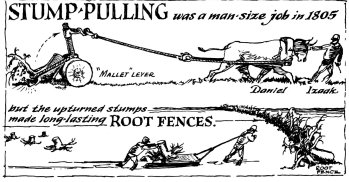

|
1805The House Of Worship was very cold. In the early 1800's it was considered improper to put a stove in a place of worship. People came to church in great fur coats and lap robes. The preacher stood on a tin of hot coals and wore heavy fur mittens while he conducted services. The long drive to church during winter was made comfortable by a small charcoal stove under the lap robes, and when you entered church you took your stove with you. Stump pulling and finding hoop wood were spring chores. After the ground had heaved and settled and winter was done, roots were looser and big tree stumps were then easier to pull out. The tough roots were impossible to burn, so farmers pushed them into a fence formation which wasn't very attractive but lasted much longer than an ordinary fence. Coopers used the hoop wood to make barrels and buckets. In May when the black ash and hickory are alive with new sap, six foot poles were cut from the saplings. After a good soaking the poles were pounded and "rived" or cut into strips for making barrel hoops. You just pounded the softened wood strip around a barrel and when it dried you had a hoop as hard as iron and even outlasted metal.
Looking at old-time workmanship, I have heard the remarks that you couldn't afford to do that today, or they had all the time in the world then. Both statements are so untrue. We are richer now than ever. The lack of mechanical time-savers made the early American's work day about three times as long as our present day.
|Cinnamon| |Crackers| |Preserving Husbands| |Buffalo Stew| |Homemade Candy| |First White Traders| |Virginia Hams| |1805| |First Snowfall| |Roast Beaver| Mice Pie| |Hominy| |Homemade Bread| |Bath Tub Gin| |Homemade Sausage| |What's In Season?| |The Old School House| |Laundry| |A Taffy Pull| |Marshmallows| |Making Catsup| |Homemade Icecream| |Fried Chicken| |Crocks of Dill Pickles| |Those Personal Things| |Homemade Salad Dressing| |Cottage Cheese| |Homemade Mustard|
|